This document answers frequent questions about the Dropshipping Import Products for WooCommerce and helps you when your WooCommerce product import is not working!
Contents
- Despite the import configuration, products are not added, the NOTICE appears: Category for product is not mapped and product will be skipped.
- During the import, a message appears: NOTICE: Waiting, another process is importing now.
- The mapping of embedded variants is not working correctly. Only one variant is added and the others are skipped. What can I check?
- What shall I do if the product update (import) does not work?
- When the browser is off, the import proceeds slowly or not at all, even though WP Cron tasks are set every minute. What to do?
Despite the import configuration, products are not added, the NOTICE appears: Category for product is not mapped and product will be skipped.
Depending on how many levels (hierarchy) of categories you want to have, you need to define all categories and subcategories. Let's assume that the product you want to import (football shorts) has a category like this one: Football/Men. If the product is to be placed in both the main category and two subcategories, each of these categories must be mapped.
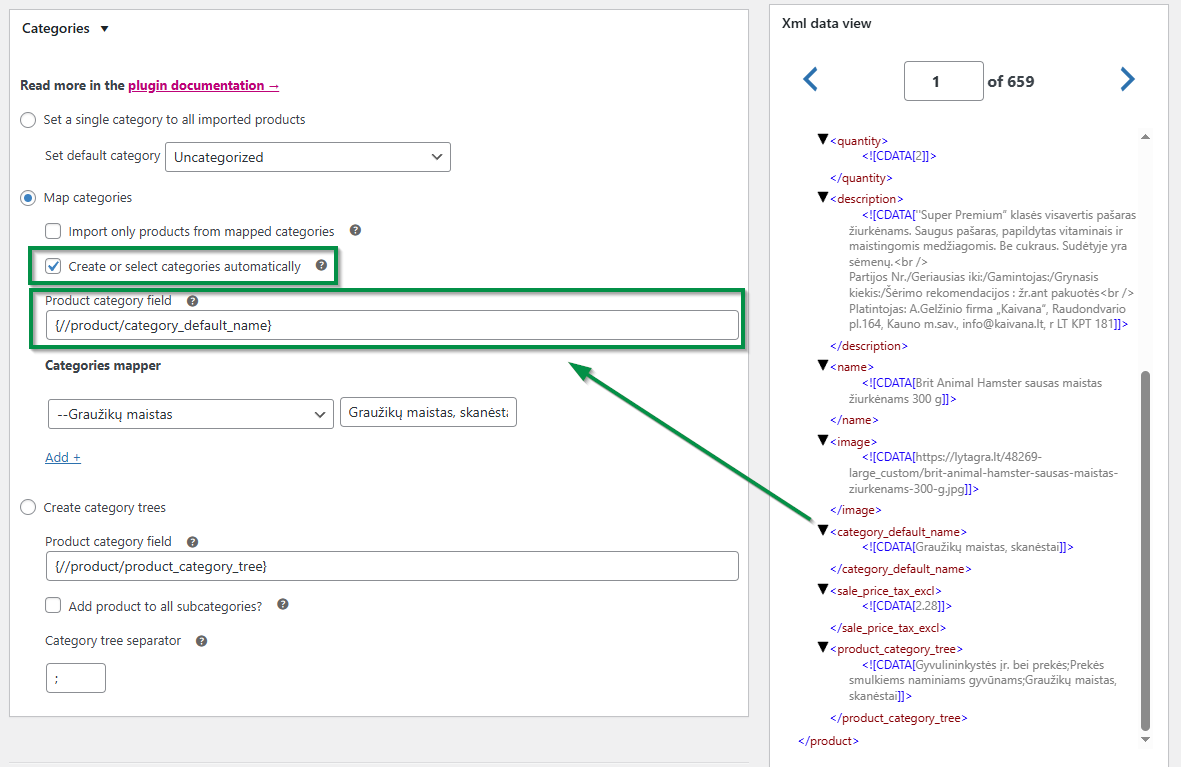
First, select Create or select categories automatically in the import mapper. This option will allow you to create categories in the store according to the file record during the first import, i.e. the Football/Men category will be added to the store.

After completing the first import, select the Create category trees option. This will ensure that during the next import, the plugin creates a category tree based on the category entries in the file.
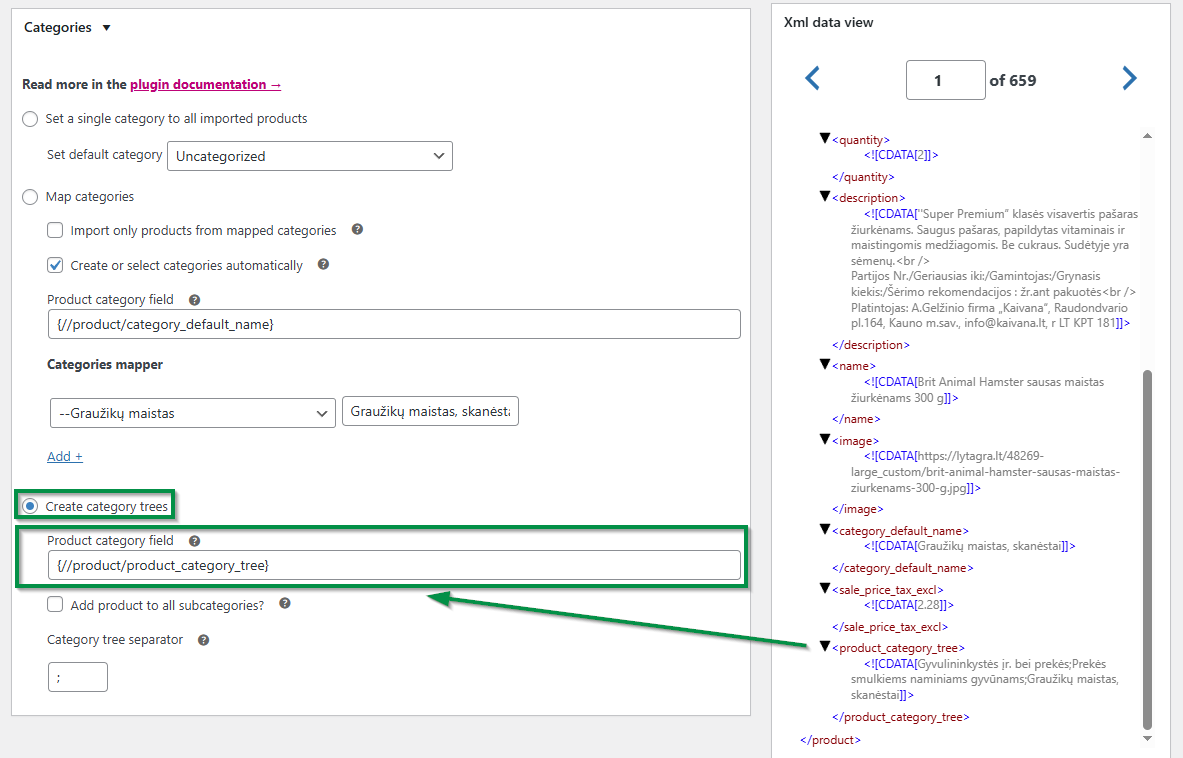
It’s important to set the separator correctly in the Category tree separator field. Providing the correct separator ensures that the plugin can generate the category tree properly. The effect will be as follows.

Football
- Men
Next, you can start mapping the category tree which was prepared in this way.
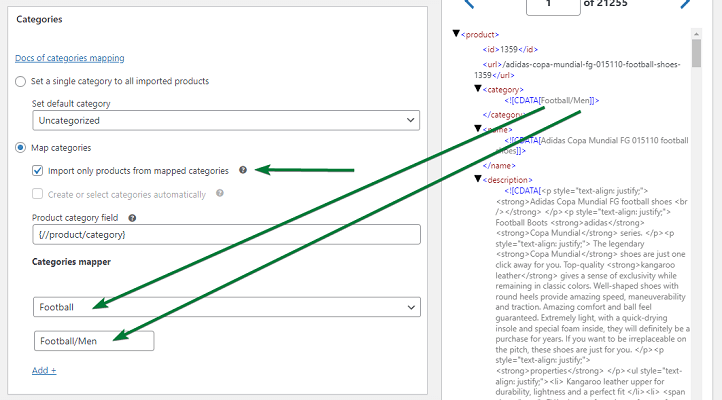
You will find two fields in one row, in the categories mapper. On the left, select one of the categories from your store, on the right, add the category ID from the feed. If the file does not have a category ID, you need to put a category name in the field, in this case, it will be Football/Men. You can add more rows, which will allow you to map full category trees:
Football > Football/Men
- Men > Football/Men
The effect will be as follows, the product will be added to the parent category Men and the Football subcategory.
During the import, a message appears: NOTICE: Waiting, another process is importing now.
This happens when at least two imports are scheduled at the same time. The plugin can perform one import at a time. If you set more imports to run at the same time in the Cron schedule, you may see this message.
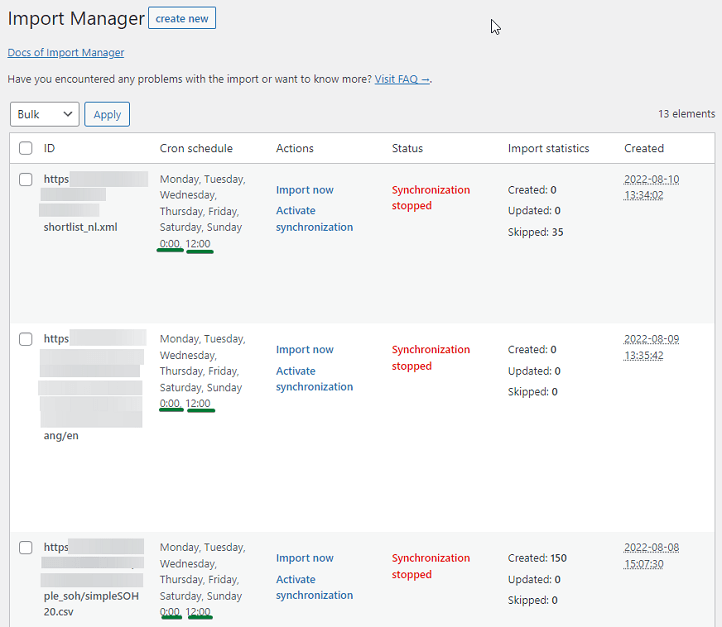
The plugin will wait until the first import is finished, and then it will start the next one. So it's a good idea to set the Cron schedule so that individual imports don't overlap. Otherwise, a queue of imports will start to form, which means they will be initiated later than you expected.
The queue of tasks (imports) will gradually increase. This can lead to malfunctioning of the plugin and importing products with a delay.
The mapping of embedded variants is not working correctly. Only one variant is added and the others are skipped. What can I check?
An important part of the correct mapping of embedded variants is proper mapping of the variant tree. We use the option Variable products are embedded as child tags in XML. Let's assume that the structure of the file looks as follows:
<sizes>
<size id="B" code="3127-B" weight="800">
<price gross="9.99" net="8.12"/>
<srp gross="0.00" net="0.00"/>
</size>
<size id="D" code="3127-D" weight="800">
<price gross="9.99" net="8.12"/>
<srp gross="0.00" net="0.00"/>
</size>
<size id="F" code="3127-F" weight="800">
<price gross="9.99" net="8.12"/>
<srp gross="0.00" net="0.00"/>
</size>
</sizes>
Which tag <size></size>, <sizes></sizes>, or perhaps ID should be drop into the mentioned field? Adding the appropriate tag makes a difference. In this case, you need to drag the second one, so that the {//product/sizes/size} rule is in the field. After selecting the link open window with variations, a window with all the variants for the specified product will appear.
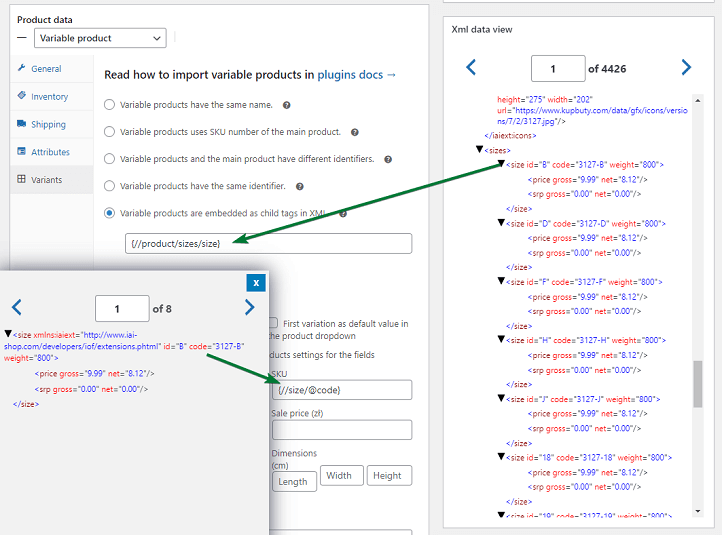
Further, drag the tags from this window that will have the value {//sizes/@code}, for the SKU number. What happens if you drag the <sizes></sizes> tag? First, you will get the {//product/sizes} rule, so when you open the window, all the variants will appear. And you will be able to add only one to the mapper.
For the SKU field, the {//sizes/size[1]/@code} rule will be used, which will cause only the first variant to be added to the store. When adding rules for the other variants, you will add {//sizes/size[2]/@code} or {//sizes/size[5]/@code}. No matter which one, you choose, it will always be only one variation.
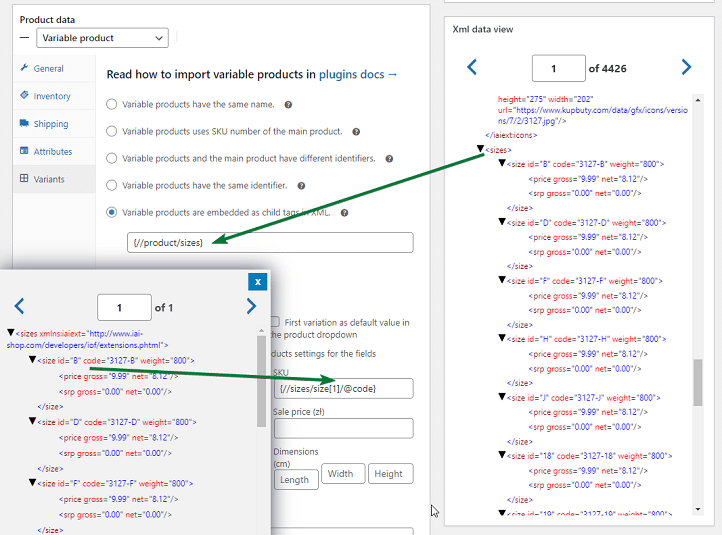
Try to map the variants so that there is only one variant per card in the variant window.
What shall I do if the product update (import) does not work?
First of all, check if any errors were noted in WooCommerce during import. Errors may appear in the admin panel, when you prepare the import. If you find this type of message, send its content in a message when contacting our support.
It also happens that a problem may have occurred, but the error message is not displayed. If the import is taking an unusually long time, or if it doesn't want to complete, check the WooCommerce Logs for possible errors or warnings.
Go to WooCommerce > Status > Logs and check if there are any fatal errors or notices. An example message might look like the following:
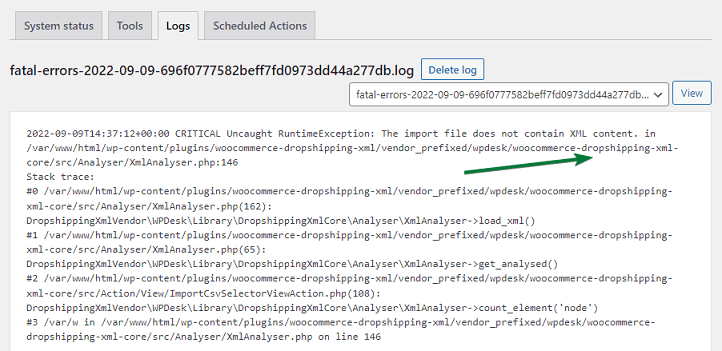
2022-09-09T14:37:12+00:00 CRITICAL Uncaught RuntimeException: The import file does not contain XML content. in /var/www/html/wp-content/plugins/woocommerce-dropshipping-xml/vendor_prefixed/wpdesk/woocommerce-dropshipping-xml-core/src/Analyser/XmlAnalyser.php:146
Stack trace:
#0 /var/www/html/wp-content/plugins/woocommerce-dropshipping-xml/vendor_prefixed/wpdesk/woocommerce-dropshipping-xml-core/src/Analyser/XmlAnalyser.php(162): DropshippingXmlVendor\WPDesk\Library\DropshippingXmlCore\Analyser\XmlAnalyser->load_xml()
#1 /var/www/html/wp-content/plugins/woocommerce-dropshipping-xml/vendor_prefixed/wpdesk/woocommerce-dropshipping-xml-core/src/Analyser/XmlAnalyser.php(65): DropshippingXmlVendor\WPDesk\Library\DropshippingXmlCore\Analyser\XmlAnalyser->get_analysed()
#2 /var/www/html/wp-content/plugins/woocommerce-dropshipping-xml/vendor_prefixed/wpdesk/woocommerce-dropshipping-xml-core/src/Action/View/ImportCsvSelectorViewAction.php(108): DropshippingXmlVendor\WPDesk\Library\DropshippingXmlCore\Analyser\XmlAnalyser->count_element('node')
#3 /var/w in /var/www/html/wp-content/plugins/woocommerce-dropshipping-xml/vendor_prefixed/wpdesk/woocommerce-dropshipping-xml-core/src/Analyser/XmlAnalyser.php on line 146
You can clearly see from the path wp-content/plugins/woocommerce/dropshipping-xml that the noted problem is related to the Dropshipping XML plugin. If you find this type of message, please contact our support and send the error content in the ticket.
When the browser is off, the import proceeds slowly or not at all, even though WP Cron tasks are set every minute. What to do?
Check if the server parameters meet our recommendations. You can find them above in the documentation. If the parameters are fine, make sure that Cron really executes every minute.
Install a plugin for managing Cron, for example, Advanced Cron Manager, go into tasks, and refresh the view every minute. You can check whether the tasks that are in progress are disappearing from the queue.
If Cron is executing properly, change the number of products processed at one time in the plugin settings. Go to Dropshipping XML > Settings and increase the product limit in the Products in one batch option.
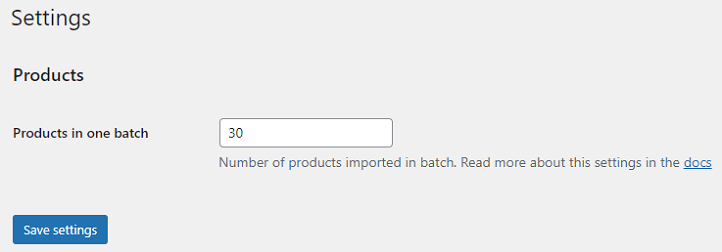
If the import still proceeds at an unsatisfactory rate, see if disabling the image download will help. Importing images can consume a lot of server resources. If the images are already uploaded, consider disabling images import when updating the import settings.
Go to Dropshipping XML > Import manager and select the feed with the problem. Select the link, edit options.
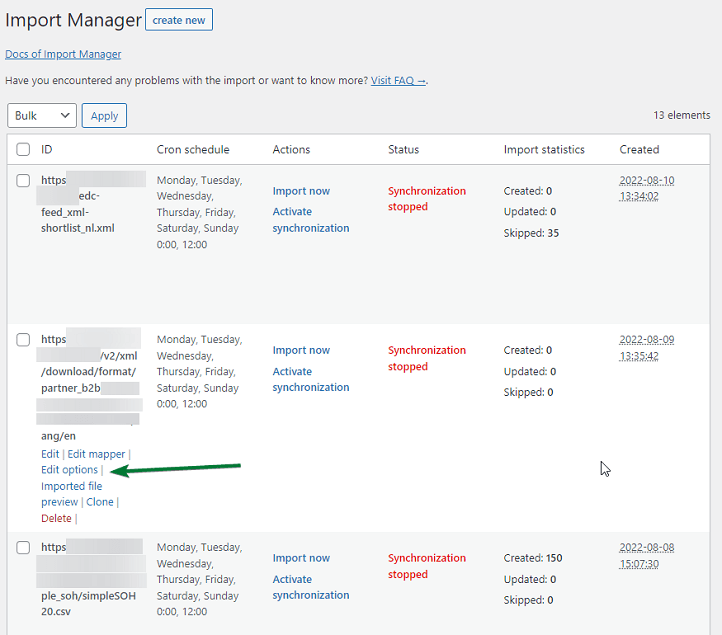
Delete Product Images from the Synchronize product fields option.
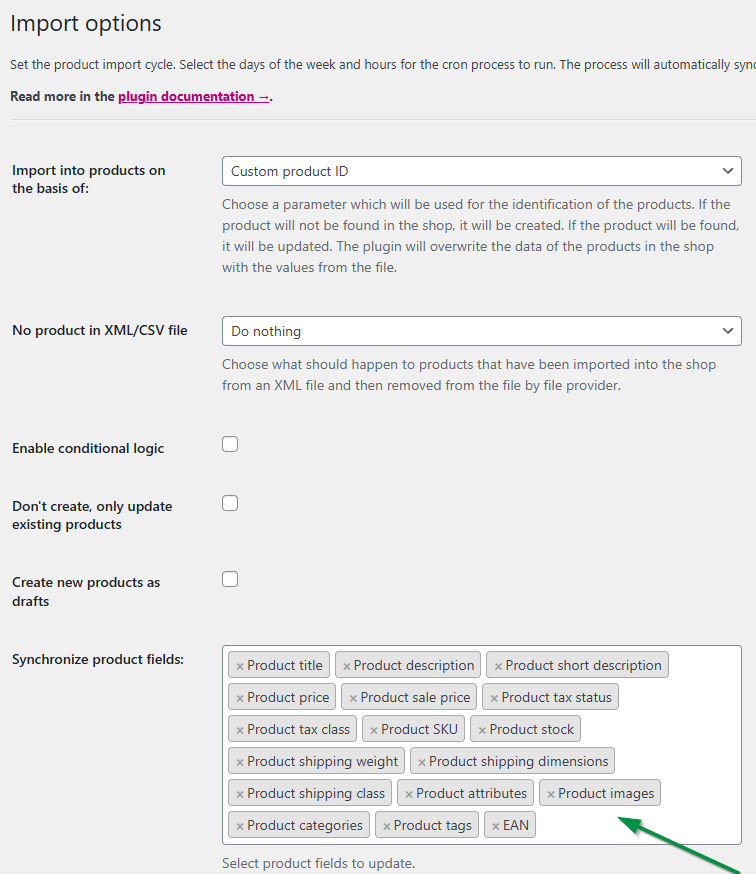
If the above measures do not help, check whether any of the plugins installed in the store or the theme you are using don't run into conflict with our plugin. To do this, disable all plugins except WooCommerce and plugins from WP Desk for the test and run the import.
If it speeds up, it will mean that one of the plugins or the theme conflicts with our plugin. Enable the plugins one by one and test after enabling each successive plugin to see if the import slows down. As soon as the import slows down, you will find the source - the plugin that is slowing down the import.
If the import still doesn't speed up, it's worth checking whether the conflict is generated by the theme used in the store. If changing the theme to Storefront, for example, does not improve the import speed, you may get the WooCommerce system status, and contact our support.
